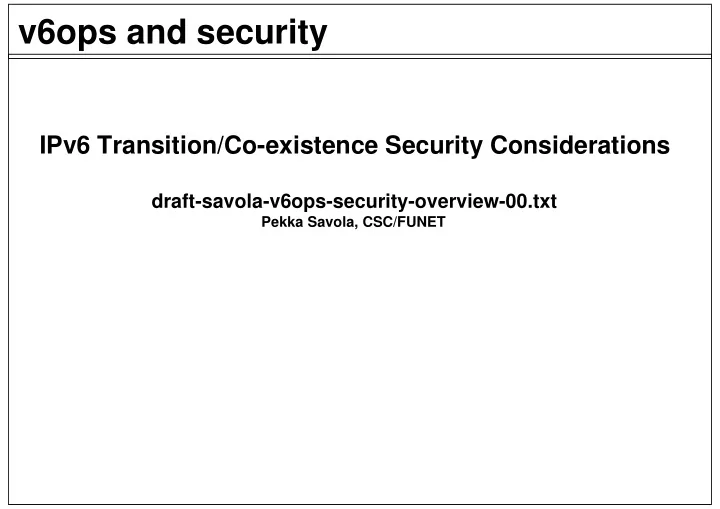

v6ops and security IPv6 Transition/Co-existence Security Considerations draft-savola-v6ops-security-overview-00.txt Pekka Savola, CSC/FUNET
Overview Overview Look at different kinds of issues IPv6 protocol Transition mechanisms in general Deployment + general observations What should we do about it? Very prominent in the charter, something needs to be done An abstract approach Which drafts would be applicable/which work should be initiated Adopt some drafts / initiate some new work?
Different kinds of issues Different kinds of issues (the IPv6 protocol suite) Protocol itself (some generic, some more specific) Some people afraid of increased end-to-end transparency people used to the NAT "security model" education required; need a mechanism to control access Some people afraid of increased end-to-end encryption people used to the perimeter firewall "security model" due to key mgmt difficulties, may not be a huge problem highlights the need for end-host, distributed, managed firewalling Issues in specifications how hosts should parse Routing Headers how privacy addresses’ applicability is not clear how ICMPv6 messages may be generated in response to multicast packets how neighbor discovery "on-link" sending model causes complications etc.
Different kinds of issues Different kinds of issues (transition) Transition/Co-existence tools Tunneling in general UDP tunneling typically punches through NATs *AND* firewalls; breaking assumptions configured IPv6-in-IPv4 tunneling slightly better (typically explicit allow/disallow) Automatic tunneling mechanisms the risks of packet forgery and DoS attacks increase the virtual topologies, especially ad-hoc ones, make the network architecture more complex Relay issues communication with third parties in automatic tunneling unless carefully done, increases the risk of DoS etc.
Different kinds of issues Different kinds of issues (deployment) Issues in deployment Problems with IPv4/6 dual stack use certain cases of deployment may incur large timeouts (as presented) quality of IPv6 routing globally is inferior to IPv4: worse quality some applications don’t handle all the fallbacks properly some DNS servers/load-balancers abuse AAAA-querying resolvers Insecure service piloting testing services/applications without proper access controls Operational factors in network infrastructure unstable(r) router software, causing virtual topologies or breaks for "production" v4 slower processing (non-line-speed), causing hacks like MPLS missing features (e.g. no ability to turn off IPv6 telnet access) insecure default configuration/assumptions (if IPv4 access is restricted, IPv6 may be allowed by default unless explicitly disallowed) costs of running one protocol (multiple topologies) vs two protocols (double the processing)
Different kinds of issues Different kinds of issues Things to note in general Prefer native IPv4/IPv6 security issues greatly simplified Accept configured tunneling plain and simple where necessary, try to avoid if possible explicit knowledge of the end-points: a lot fewer risks Avoid automatic tunneling security properties typically difficult to handle usually bring on a lot of complexity may be difficult to retire ("sunset strategy")
What should we do? What should we do about security? Charter lists a lot of items of IPv4/IPv6 operations 1. solicit input on sec issues from operators/community 2. provide feedback to IPv6 WG on specs which are likely to cause sec issues 4. publish docs on security risks of the operations (w/ sec area) 5. identify sec issues in deployment scenarios/solutions So.. We had better DO something! Security is about the most important item on our charter But what to do? Good question! Feedback sought..
What should we do? What should we do about security (generic)? We need more security expertise To evaluate security aspects of the proposals from the first And to help in figuring out an answer to the all of below We need better idea how to evaluate security How to deal with issues transparency etc. imply? specify local access control mechanisms? try to see if there’s work on end-host firewalling? How to deal with issues NAT/firewall traversal imply? do we need to do more than what other NAT traversal mechanisms have done (=nothing)? probably yes, but what? How to deal with the evaluation of transition mechanisms? how much complexity is "too much"? how much security is "enough"?
What should we do? What should we do about security (concrete)? Current drafts which could be applicable to this WG draft-dupont-ipv6-rfc3041harmful-02.txt draft-savola-ipv6-rh-ha-security-03.txt draft-savola-ipv6-rh-hosts-00.txt draft-cmetz-v6ops-v4mapped-api-harmful-00.txt + draft-itojun-v6ops-v4mapped-harmful-01.txt draft-bellovin-ipv6-accessprefix-01.txt + draft-zill-ipv6wg-zone-prefixlen-00.txt something like this is very much in scope draft-savola-v6ops-6to4-security-02.txt draft-savola-v6ops-firewalling-01.txt draft-savola-v6ops-security-overview-00.txt draft-okazaki-v6ops-natpt-security-00.txt
What should we do? What should we do about security (concrete)? Adopt some of the previous drafts? Good candidates draft-savola-v6ops-6to4-security-02.txt draft-savola-v6ops-firewalling-01.txt If not adapt, push for being worked on (security area? IPv6 wg?) draft-bellovin-ipv6-accessprefix-01.txt or draft-zill-ipv6wg-zone-prefixlen-00.txt Should we start working on something new? Bring in that security input from the ops/users community! How to go about those issues in IPv6 specs? Need to create two documents on security? *ARE* there issues to document? (ch4): potential security risks in the operation of IPv4/IPv6? (ch6): identify open sec issues with deployment scenarios? If so, maybe need a small editorial team (or DT).
Recommend
More recommend